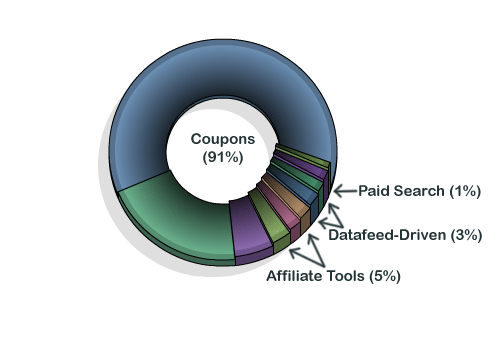When I audit affiliate programs, one of the first things I analyse is how diversified their affiliate base is. It isn’t unusual for the chart to look something like this:
Does the above pie chart look familiar? Keep reading then…
No affiliate program has to be this heavily dependent on any one type of affiliates. However, the vast majority, actually, is. In fact, to some advertisers “affiliate marketing” has become nearly synonymous with the situation illustrated in the above chart.
Contrary to somewhat of a popular belief, affiliate programs’ primary marketing vehicle doesn’t have to be a discount. Yes, it often aids the conversion; and yes, working with coupon/deals-oriented affiliates who have their own email lists and ways to drive incremental business can be beneficial. But you do not have to restrict yourself to any one type of affiliates.
Today I’d like to bring you a list of eighteen types of affiliates, with the vast majority of which you are probably not even working yet. Treat the below as a checklist and if an affiliate type fits your vision for your affiliate marketing program, do consider recruiting them into your affiliate campaign.
Affiliate tools — tools used by publishers for monetization of their online properties (e.g. VigLink, SkimLinks, GoldenCAN)
Charities — groups and organizations looking to raise money for a cause
Content producers — bloggers, article writers, and other content-driven websites (per AffiliateBenchmarks 2013 Global Advertiser Research Report this is the most desired type of affiliates out there)
Co-registration affiliates — marketers promoting products or services related to the primary one in which the customer expressed interest (or demographically suitable to the target audience)
Coupons and deals — websites primarily focused on frugal consumers or those looking for additional sales and discounts
Datafeed-driven websites — shopping directories/aggregators and price comparison engines, powered by data feeds
Domain-oriented affiliates — solutions monetizing mistyped versions of the advertiser’s URL (e.g.: Barefuit) or other domain-related situations
Email marketers — affiliate marketers who maintain targetted email lists (do inquire with your content producers, couponers, and other types if they have email lists; because they frequently do)
Loyalty affiliates — affiliates offering cashback, virtual currency, employee perks, or other types of rewards/incentives for consumers to convert (may not work for some affiliate programs | more here)
Mobile-oriented affiliates — from mobile app developers to mobile search marketing and those that marry click-to-call with pay-per-call, this is another (broad!) type of affiliates worthy of your attention
Paid Search affiliates — affiliates driving traffic/conversions by means of paid search marketing (e.g.: imwave, TriMax Media)
Pay-per-call publishers — marketers driving inbound phone calls being compensated on performance basis (more here)
Ranking/review sites — affiliates focused on publishing ratings, ranking lists, and/or reviews (e.g.: TopTenReviews.com)
Remarketing/retargeting solutions — online marketers that offer outsourcing remarketing and/or retargeting for affiliate-model compensation (e.g.: UpSellit.com, Ve Interactive)
Social media publishers — niche and topical influencers that leverage their social media following
Sub-affiliate arrangements — companies with sub-publishers who are doing most of the marketing, yet profits are funneled through one master account (that of the sub-affiliate network) and no direct advertiser-affiliate relationship exists (e.g.: A4D, FlexOffers, rewardStyle)
Software/toolbars — not all of them are bad and cannibalizing/parasitic (as some of my writing may seem to imply) but you ought to fully understand how they will operate prior to agreeing to work with any (e.g.: InvisibleHand)
Video marketers — while I could bundle them up with content producers, video is a type of content that stands out from the rest, and deserves a separate mention
Keep also in mind that while all of the above exist in pure forms, it isn’t unusual for an affiliate to embrace several marketing techniques or channels. An exaggerated though not entirely unrealistic example would be a niche content producer (whose website(s) allow for user-generated reviews and rankings) with strong social media following, targetted email list, maintaining a popular YouTube video channel, relying not only on organic traffic but also utilizing paid search, and enhancing conversion by occasionally highlighting coupons and deals.
So how many of the above eighteen affiliate types is your program missing?
However many or however few, go recruit them! And do let me know if you need any extra help.

Pingback: Marketing Day: Facebook's Slideshow Ads, REI's #OptOutside Campaign & Mobile Holiday Strategies
Pingback: 7 Useful Tips for Affiliate Marketing Beginners - Blogging Tips
Hi Geno,
That’s a nice write up you put together. Very helpful. I’m new to the AM world but have known of you for a while. My question is, how do you know which affiliate networks are better at certain things as oppossed to others. For example, CJ is better with the travel vertical, but ShareASale is better with products in general. That type of thing. Is there a way or a place where I can get that type of info? Any help would be appreciated. Thanks,
Milton, great question!
Take a look at this post: Top Affiliate Program Categories on 6 U.S. Affiliate Networks.